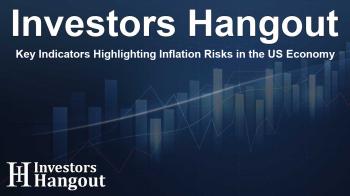Key Indicators Highlighting Inflation Risks in the US Economy

Understanding Inflation Trends and Risks
Monitoring inflation trends has become increasingly important in the current economic climate, where the Consumer Price Index (CPI) had previously surged to 9.0%. Now, with inflation levels around 2.7%, many are left observing potential shifts in macroeconomic conditions. As government policies shift, especially with new leadership on the horizon, professionals and consumers alike are on high alert as inflation shows signs of becoming more persistent.
1. Year-over-Year Change in Inflation
The year-over-year change in both headline and core CPI provides crucial insight into inflation trends. Recently, disinflation has shown signs of stalling, leading to debates about whether this can be classified as temporary noise or a significant signal regarding inflation stability. Core CPI is currently at a 3.3% annual rate—a figure that is notably above the Federal Reserve’s target of 2%. If the anticipated policy changes introduce inflationary pressures, core CPI could see further increases, raising concerns about future economic stability.
2. Consumer Index Inflation Bias Index
Another important measure is the Consumer Index Inflation Bias Index, a gauge reflecting perceptions of inflationary trends. This indicator is constructed using several conventional and alternative measures offered by the government and regional Federal Reserve banks. As some patterns emerge from this data, monitoring shifts in consumer expectations for pricing is critical in understanding inflation risks.
3. Consumer Inflation Expectations
Consumer inflation expectations have remained relatively moderate; however, recent trends indicate a rise in public concern. Analysis conducted by the Cleveland Fed suggests that optimism about inflation is beginning to wane, with public outlooks trending upward. If consumers' expectations surpass previous highs, it could signal a loss of control over the inflation narrative, raising alarm if the Fed fails to manage public perception effectively.
4. Treasury Market Expectations for Inflation
Examining the 5-year inflation expectations within the Treasury market reveals a potentially troubling trend. Two key models are utilized to analyze these expectations: the 5-Year/5-Year Forward Inflation Expectation Rate and a model based on yield spreads of nominal Treasury bonds contrasted with inflation-indexed bonds. If inflation expectations in this sector continue to rise, it could indicate more severe inflation risks ahead.
5. US Consumer Inflation Pulse Index
Finally, the US Consumer Inflation Pulse Index, a proprietary indicator featured in the US Inflation Trend Chartbook, remains a crucial fulfillment in assessing inflation dynamics. By aggregating twelve months of percentage changes among 32 different components of the CPI, this index provides a comprehensive overview of inflation trends. Currently, it suggests a moderate level of inflation bias, with its score trending upward. Should it gain further momentum, the implications for economic reflation could be alarming.
Frequently Asked Questions
What does the Consumer Price Index (CPI) indicate?
The CPI measures the average change over time in the prices paid by consumers for goods and services, indicating inflation levels.
How does core CPI differ from headline CPI?
Core CPI excludes volatile items such as food and energy prices, offering a clearer view of inflation trends over time.
Why are consumer inflation expectations important?
Consumer expectations can influence spending and saving behaviors, affecting overall economic activity and inflation.
What is the significance of the Treasury market in inflation forecasting?
The Treasury market is essential for understanding inflation expectations as it reflects investor sentiment about future price movements through bond yields.
How can the Inflation Pulse Index signal risks?
By aggregating designated components of the CPI, the Inflation Pulse Index provides an overall score that indicates inflation bias and potential reflation risks.
About The Author
Contact Caleb Price privately here. Or send an email with ATTN: Caleb Price as the subject to contact@investorshangout.com.
About Investors Hangout
Investors Hangout is a leading online stock forum for financial discussion and learning, offering a wide range of free tools and resources. It draws in traders of all levels, who exchange market knowledge, investigate trading tactics, and keep an eye on industry developments in real time. Featuring financial articles, stock message boards, quotes, charts, company profiles, and live news updates. Through cooperative learning and a wealth of informational resources, it helps users from novices creating their first portfolios to experts honing their techniques. Join Investors Hangout today: https://investorshangout.com/
The content of this article is based on factual, publicly available information and does not represent legal, financial, or investment advice. Investors Hangout does not offer financial advice, and the author is not a licensed financial advisor. Consult a qualified advisor before making any financial or investment decisions based on this article. This article should not be considered advice to purchase, sell, or hold any securities or other investments. If any of the material provided here is inaccurate, please contact us for corrections.

